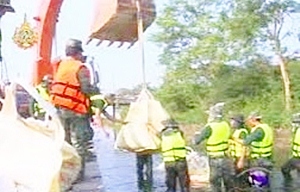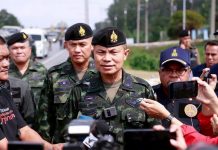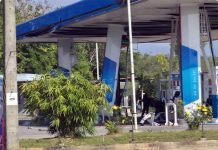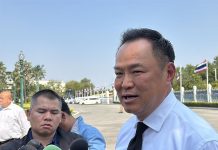BANGKOK, Nov 7 – Prime Minister Yingluck Shinawatra is considering to build additional ‘Big Bag’ barriers to control the deluge in the western part of the Thai capital after using them in northern Bangkok with satisfactory results, Transport Minister Sukumpol Suwanatat said on Monday.
Air Chief Marshal Sukumpol asserted that the ‘Big Bag’ can slow the rate of water flow in the northern parts of the capital and workers are now trying to quickly reinforce damaged barriers.

The transport minister referred to the success of operations using the one- and two-tonne sandbags piled up as a makeshift flood prevention dykes for six kilometres on the Rangsit-Muang Ek Road to reduce the volume of water flowing into Don Muang, Lak Si and Bang Khen districts, and Khlong Prapa, the main source of tap water for the capital and neighbouring provinces.
“Prime Minister Yingluck is thinking to build more flood prevention barriers along 10km Bang Sue-Talingchan route to curb the amount of water in western Bangkok,” said the minister. The authorities will study their use to determine “whether the operations could be carried out or not, as a river bridge in the area could be an obstacle.”
For water drainage from Bangkok, Marshal Sukumpol said the operations will be done in accord with the system of the Bangkok Metropolitan Administration (BMA), but the Flood Relief Operations Centre (FROC) stands ready to provide help.
The minister stated that BMA water drainage is expected to be complete in two weeks.
Transport Minister Sukumpol said he would ask the cabinet to extend toll-free expressway period after normal roads are impassable.
Floodwater has reportedly surged from drainage pipelines around 100 metres away from the premier’s home in Soi Yothinpattana 3 in Navamind Road on Monday, even as the prime minister is visiting flood victims in Ta Sai community, Laksi district.
Ronnachit Yaemsaard, acting governor of the Mass Rapid Transit Authority of Thailand (MRTA), said all 18 MRT underground stations are operating as usual although water keeps rising, but not yet at a level which poses a threat to the system.
Mr Ronnachit said the MRTA must closely monitor the flood situation at Chatuchak Station after it had earlier put three stations — Ratchadapisek, Phaholyothin, and Lat Phrao — are under close watch.
The acting governor noted his agency will decide whether and when underground stations will be closed depending on when floodwater reaches the second step of station entrances.
As of now, Mr Ronnachit explained, floodwater has hit only the first step of the entrance of the affected stations, such as Phaholyothin Station.




